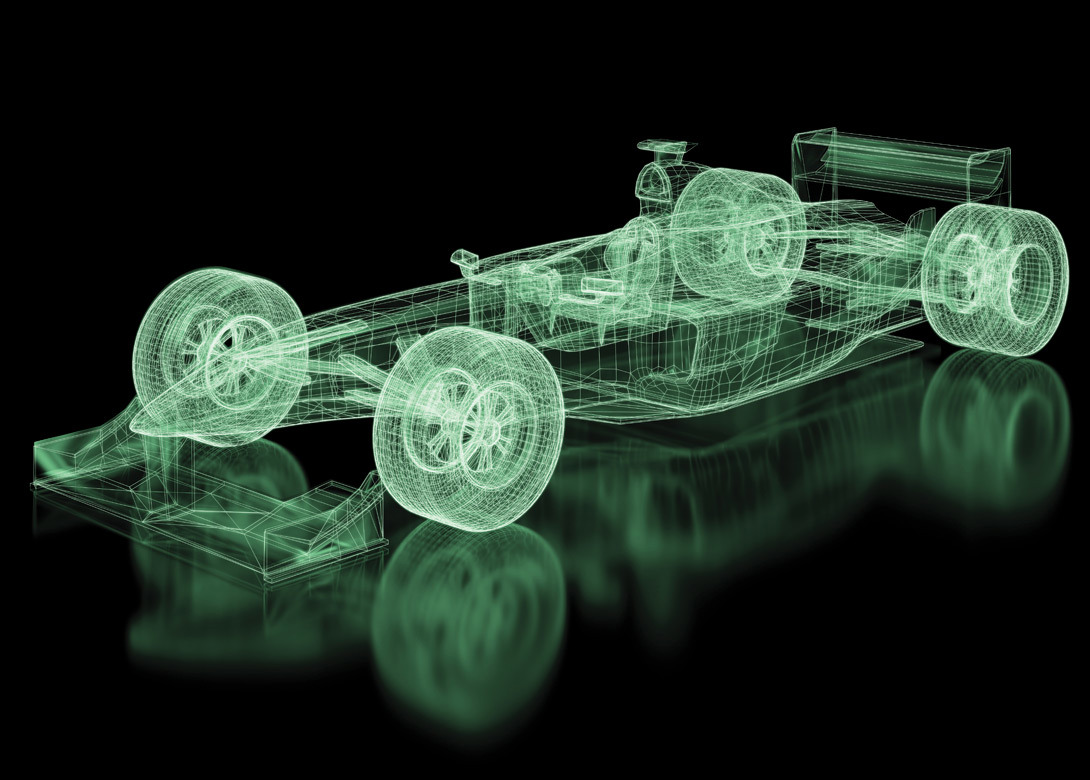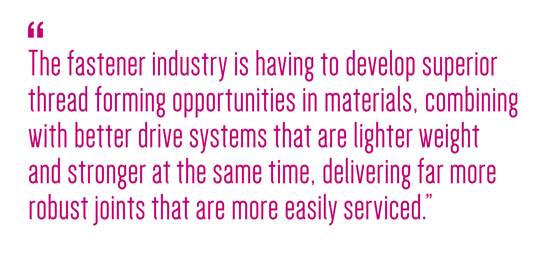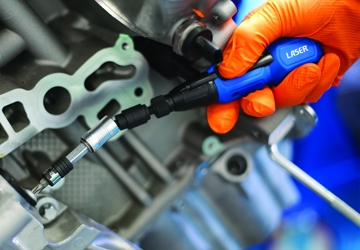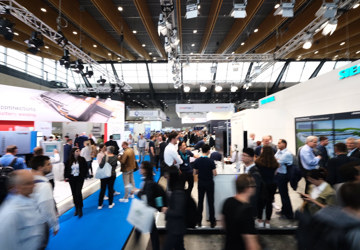

An in-depth conversation on lightweighting and fastener development with Mike Mowins, is never to be missed. Executive Editor Phil Matten caught up with him at Barton Coldform (UK) Ltd, an Optimas Company, and the most recent licensee for Phillips MORTORQ® SUPER spiral drive system.
PART ONE:
Where do you see the car industry in its lightweighting development and where is it going?
“You need to look at the lead innovators in any industry, in automotive that means high-end racing or performance - Formula 1, McLaren, Bentley and others. These are the harbingers of what will lead change going forward. We’re seeing more and more integration of lightweight materials - magnesium, carbon-fibre reinforced plastics - and more attention paid to the initial design phase of the joint.
Automotive has driven surrounding industries to address lightweighting. The fastener industry is having to develop superior thread forming opportunities in materials, combining with better drive systems that are lighter weight and stronger at the same time, delivering far more robust joints that are more easily serviced. We saw that start some years ago with the move from standard bolted joints to thread forming fasteners in engine blocks – eliminating nuts and washers and forming the thread directly into the block.
Phillips has been one of the leaders in presenting ideas at conferences like the Global Lightweight Automotive Manufacturing series.
What we see is a process that starts with the question: ‘We’ve got a joint, can we put it together and never take it apart?’ If so then adhesives are a great solution.
But, if you are ever going to have to repair, service or do anything else that requires it being disassembled, you need a threaded joint. Then the equation becomes, how do you optimise that threaded joint to be easily assembled, not stop the line with tool changes, and take as much weight as possible out of the entire assembly? The most effective answer is to look at lightweighting the entire assembly not just the components of that assembly.
You have a material that has to be thick because you need a counterbore to house your capscrew. If you can make the capscrew X percent shorter you can make your material X percent thinner and save not only the weight from the capscrew but also all of that material spread over the entire structure. We see a lot of that in seat applications where we are able to shorten the bolt holding the seat in place. That gives the opportunity to reduce the height of the seat track. A millimetre and a half out of a half metre seat track, multiplied by four tracks, and you’ve taken a significant amount of cold rolled steel out of the vehicle weight.
Look at the whole assembly, instead of being focused on the part of the assembly for which you are responsible, and you have adopted a much more synergistic approach to lightweighting. To do that, you have to be involved very early in the design phase to help the design engineer explore the different options that provide a more efficient lightweight assembly.”

So what level of awareness innately exists within the automotive industry?
“There is always the problem of inertia: ‘We’ve always done it this way, we’re always going to do it this way’ but the industry as a whole is moving.
Go from old school to ‘body in white’: Now you have a different set of parameters and now progress is easier to achieve because you have a wholesale change going on.
Start going to ‘body in black’: Now you are going from aluminium to composite. Then it is easier again because you have a sea change as opposed to divert a river.
The mental transition becomes: “Gee I’ve got to think new on this because I’ve got a whole new set of material properties involved.”
For performance sports cars, or luxury sedans, the automotive industry has the price mark to adopt advanced materials – in fact they become a marketing advantage. A medium sized, high volume sedan, though, is still fundamentally manufactured in steel. So what happens here?
“It’s interesting when you look at the history. In North America the Saturn was the first plastic car, beyond the Corvette. Now you are looking at more and more bolt-on plastic pieces, replacing aluminium pieces, replacing sheet steel pieces.
Look at the standard, high-volume sedan and there are economic inhibitors but a significant element of the progress now comes from new talent entering engineering. As some of the old guard engineers retire out of assembly the baton is passed to new engineers coming up from a very different tradition and from a very different educational environment. They are more attuned to CAD than 2D and more amenable to saying “OK, if I just change this in the CAD how does that affect the whole structure?” They are more willing to be outside of the norm with a solution than historically because they don’t have the same ownership as their predecessor.”
What about the crossover and feed through from aerospace?
“We’re seeing more and more crossover and feed through from aerospace but also the converse. The aerospace industry is always concerned about weight. Every kilo taken out of the airframe is a saving of 30 tonnes of kerosene a year.
There are certain technologies coming over from the aerospace world. With more aluminium body in the car world that has to be assembled and disassembled, 100-degree flush heads replaced 90-degree flush heads because that’s what aerospace has lived with forever.
Conversely, Boeing and Airbus face massive back orders for single aisle airframes, so they need to go from 28 aircraft a month and start knocking on the door of 48 and then 60 aircraft a month. That means adopting automotive - and hey, now we’ve got moving assembly lines in the aerospace world that you never had before.
It is an interesting cross-pollination. Aerospace’s quest for quality at no incremental cost is coming over to the automotive side. Automotive PPAP early qualification is moving over to aerospace.”





